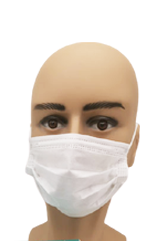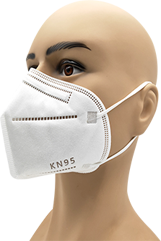How to Manufacture Surgical Mask?
Hangzhou Shijie Health Technology Co.,Ltd will introduce the process of manufacturing surgical masks. We hope it will be helpful to you.
1. Polypropylene fiber production
Just as textiles require plant fibers, the production of nonwoven fabrics also requires fiber materials. Polypropylene particles are used to melt and shape, and high-agglomerating polypropylene fiber material, that is, the raw material of nonwoven fabrics, is the core raw material for the production of masks.
2. Melt blowing nonwoven fabric production
Melt Blowing is a polymer extrusion non-woven process, whose principle is to use high-speed hot air to draw the thin stream of polymer melt extruded from the die orifice, thereby forming ultra-fine fibers condensed on net curtain or roller, relying on self-bonding to become a nonwoven fabric.
Melt-blown material is made by heat melting of its own fiber, and the thickness is thicker. In the nonwoven fabric produced by melt blowing, the random fibers and the interlayers are crosswise arranged to form a multi-curved channel structure of the melt-blown material, so that the particles (COVID-19 aerosol) will collide with the fibers and be retained.
The filtering mechanism of an antiviral surgical mask includes brownian diffusion, retention, inertial collision, gravity settling and electrostatic adsorption. The first four are physical factors, which are the natural characteristics of nonwoven fabrics produced by melt blowing, with a filterability of about 35%, which does not meet the requirements of surgical masks. So we need to electret the materials to charge the fibers and use static electricity to capture the aerosol where the COVID-19 is located.
3. Electret treatment
Electrostatic adsorption is the capture of COVID-19 droplets (aerosols) through the Coulomb force of charged fibers. Its principle is to make the surface of the filter material bigger, the ability to capture particles is enhanced, and the charge density is increased, and the adsorption and polarization effects of particles are stronger. Therefore, the meltblown nonwoven filter material of the filter layer can reach the filterability of 95% without changing the respiratory resistance only after electret treatment, and then the virus can be effectively prevented.
Masks must achieve a barrier effect while ensuring comfortable ventilation. The inhalation resistance of surgical masks generally does not exceed 343.2 Pa, and the inspiratory resistance of civilian masks is less than 135 Pa.
The electret treatment can greatly improve the filtration efficiency without changing the respiratory resistance, and the higher the electret voltage, the higher the material filtration efficiency. Generally, the electret voltage should be 30kv-60kv, and the electret time should be more than 20 seconds.
4. Mask production line
After the problem of raw materials is solved, the manufacturing process of surgical masks is stacking works and materials to maintain the production line capacity, which is very fast with all automated production lines.
5. Ethylene oxide disinfection
An ordinary mask does not need to be disinfected, but the medical surgical mask needs to be disinfected by the manufacturer with an ethylene oxide (EO) disinfection cabinet. Put the mask in a 400mg/L ethylene oxide environment, and use alkylation to act on the hydroxyl group to inactivate the microbial macromolecules and achieve the purpose of sterilization. 7 days are needed for analysis after disinfection. When the EO residue is lower than the required value, it can be packaged and delivered to medical staff.




